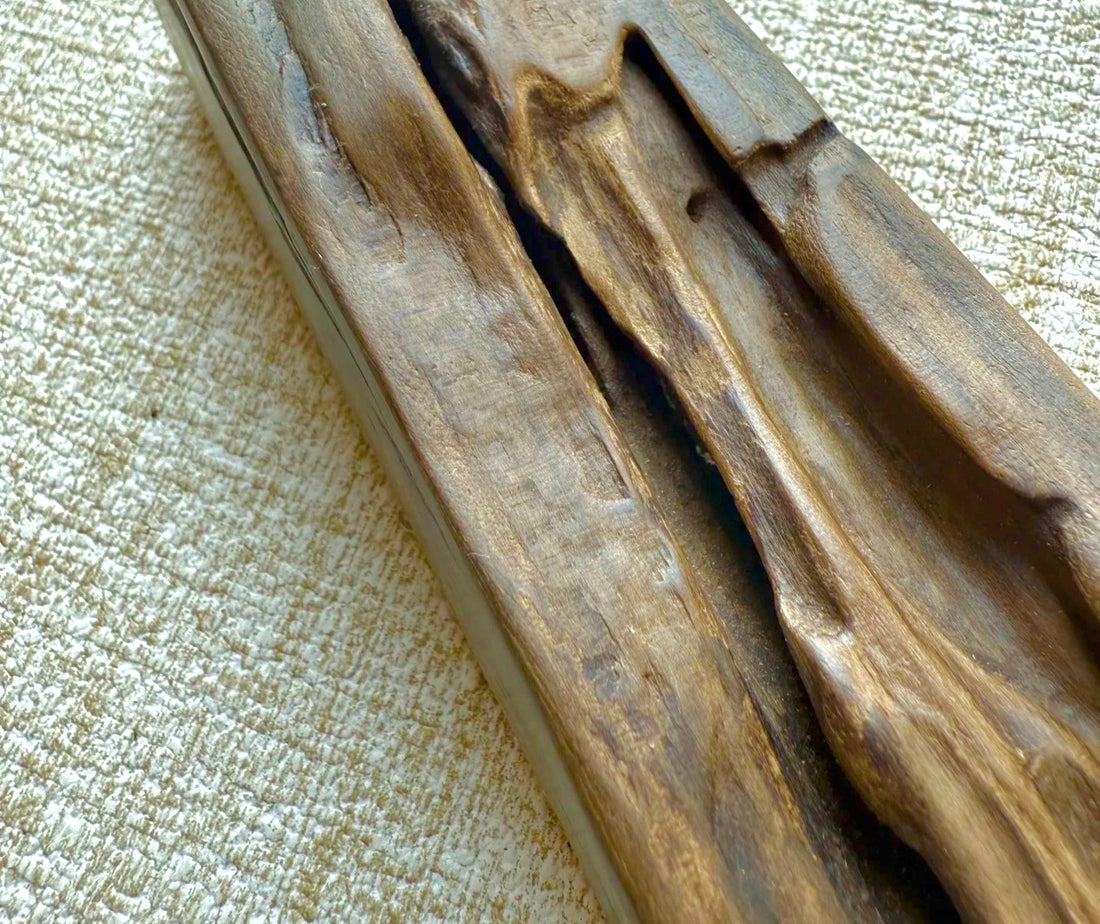
What Does Sandalwood Smell Like? | Auraspring Practical Guide to Its Aroma & Uses
Share
Sandalwood has been treasured for centuries in temples, perfumes, and homes.
But if you’ve never smelled it before, you might wonder: what does sandalwood actually smell like?
Most articles describe it vaguely as “woody and creamy,” but the truth is far more nuanced.
In this guide, I’ll share not only the chemistry and cultural history of sandalwood, but also my personal experiences with its scent—why good sandalwood feels like a companion rather than an overpowering fragrance.
The Core Scent of Sandalwood
The warm, grounding aroma of sandalwood comes mainly from santalol, its primary essential oil component. This molecule is responsible for the soft, milky, and slightly sweet quality that distinguishes sandalwood from sharper woods like cedar or pine.
- Woody → deep and earthy, but smoother than oak or cedar
- Creamy → warm, buttery, and comforting
- Sweet → subtle, never sugary, often balanced by spice
- Velvety → a roundness that feels soft and full
👉 If cedarwood is like walking in a crisp winter forest, sandalwood feels more like being in a warm study lined with polished wood and old books.

My Personal Experience with Sandalwood
To me, sandalwood has a creamy, milky aroma—but without the cloying sweetness you sometimes find in vanilla. The best sandalwoods feel refined and balanced.
- Some carry a menthol-like freshness, almost cooling in their top notes.
- Others lean toward a darker, deeper character, giving an impression of gravitas and stillness.
- The key marker of quality sandalwood, in my view, is that it’s never cloying. Even in a small, enclosed room, lighting a stick of sandalwood incense doesn’t overwhelm—it settles around you like a steady presence.

Good sandalwood is thick and textured, not flat. Older sandalwood, aged over decades, develops a caramel-like depth, thanks to its natural oils. These oils slowly release layered notes: creamy, resinous, and slightly nutty, like a “walking perfume” with gentle persistence.
By contrast, newer sandalwood sometimes carries a slightly sour brightness, making it more playful and lively. Both have their charm, but old sandalwood brings a gravitas that feels timeless.
👉 If you’d like to experience this depth for yourself, our
blends sandalwood with other natural herbs to create a soothing, introspective atmosphere. For a more protective, grounding character, try our
which also carries sandalwood’s steadying warmth.
Sandalwood in Comparison
To give context:
- Sandalwood vs. Cedarwood → Cedar is crisp, dry, and airy; sandalwood is warmer, creamier, and more enveloping.
- Sandalwood vs. Pine → Pine is sharp and refreshing; sandalwood feels deeper and slower, almost like it settles into the air.
- Sandalwood vs. Oak → Oak is robust and earthy; sandalwood is smoother, with less roughness and more elegance.
This is why sandalwood adapts so well across perfumes, incense, and home fragrances—it can stand as a foundation note while still harmonizing with brighter companions.
The Many Ways Sandalwood Is Used
Sandalwood isn’t just one smell—it transforms depending on the context:
- Perfume → A base note that anchors amber, patchouli, or rose, extending longevity.
- Incense → Used for meditation because it feels grounding without being suffocating.
- Essential Oil → Its santalol content has been studied for relaxation, anxiety relief, and improved sleep.
- Candles → Adds sophistication to living spaces, striking a balance between clean and cozy.
- Skincare & Ayurveda → Long valued for its cooling, balancing, and anti-inflammatory properties.
👉 At Auraspring, our sandalwood incense and candle collections are designed to carry these qualities across settings—whether you need a calm evening ritual, a focused workday atmosphere, or a grounding meditation aid.
Cultural and Historical Significance
Sandalwood has been intertwined with culture for thousands of years:
- India: Sacred in Hindu rituals, burned in temples and used in purification ceremonies.
- China & Japan: Incorporated into incense rituals to enhance meditation and clarity.
- Middle East: Valued in perfumery for its ability to soften and balance stronger notes.
This makes sandalwood more than just a scent—it is a cultural symbol of peace, sanctity, and continuity.
Indian vs Australian Sandalwood
The two main commercial varieties have distinct profiles:
- Indian Sandalwood (Santalum album) → Sweeter, creamier, highly prized but rare due to overharvesting.
- Australian Sandalwood (Santalum spicatum) → Earthier, slightly drier, and more sustainable.
Both are beautiful, but knowing which one you’re experiencing can explain subtle differences in aroma.
FAQs About Sandalwood’s Smell
Is sandalwood masculine or feminine?
Both—it works as a grounding note in men’s colognes and a creamy warmth in women’s perfumes.
Does sandalwood last long?
Yes. As a base note, it lingers for hours or even days.
Why does sandalwood feel calming?
Because santalol interacts with our olfactory system in ways linked to lowered stress responses, while the woody notes connect us psychologically to the grounding effect of nature.
How do I know if I’m smelling real sandalwood?
Look for Santalum album or Santalum spicatum. Synthetic sandalwood fragrances are common and often labeled simply as “sandalwood oil.”
Final Thoughts
So, what does sandalwood smell like?
For me, it’s the perfect balance of milky warmth and woody depth, layered with subtle sweetness and refined calm. The best sandalwoods reveal texture and oiliness that feels alive—never cloying, never thin.
From sacred temples to modern homes, sandalwood has endured because it’s not just a fragrance—it’s a presence. A scent that steadies, grounds, and comforts.
👉 Want to bring sandalwood into your own space?
Discover the Auraspring Candle & Incense Collection crafted to carry this timeless fragrance into your daily rituals.
